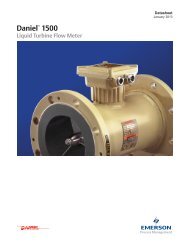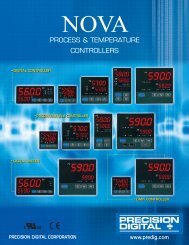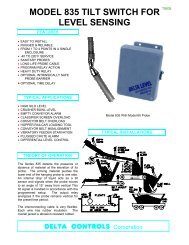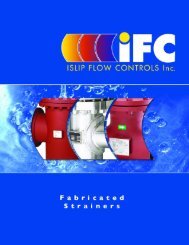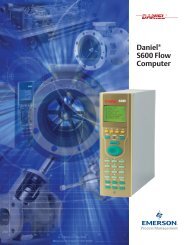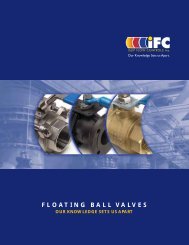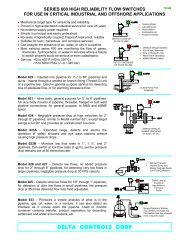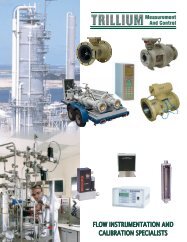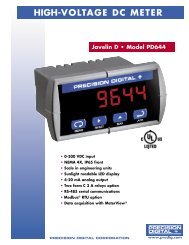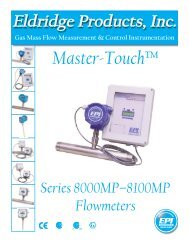Create successful ePaper yourself
Turn your PDF publications into a flip-book with our unique Google optimized e-Paper software.
13428 TC IFC <strong>Check</strong> 11/10/06 8:46 AM Page 36<br />
Silent <strong>Check</strong> Valve<br />
Installation and Maintenance Instructions<br />
Silent <strong>Check</strong> Valve<br />
Installation Requirements<br />
1.0 Valve Location and Orientation in Piping<br />
The IFC Silent <strong>Check</strong> Valve is designed to open fully to allow<br />
forward flow and close rapidly prior to flow reversal.<br />
These valves are used to prevent reverse flow through<br />
pumps or in piping systems. IFC Silent <strong>Check</strong> <strong>Valves</strong> are not<br />
intended for use with fluids containing suspended solids such<br />
as wastewater, or any type of hazardous gas. <strong>Check</strong> valves<br />
should be installed a minimum of 3 pipe diameters from<br />
other line elements. i.e. elbows, pumps, valves, etc.<br />
When the valve is to be reassembled, carefully place the disc<br />
and seat in the valve body to prevent damage to lapped or<br />
soft seat. Reinstall the valve in the line using new flange<br />
gaskets, and replace and torque the bolts using the crossover<br />
flange bolt tightening the method.<br />
CAUTION: The valve seating should never be<br />
inspected by only removing the valve inlet flange<br />
piping, because seat damage or injury could occur.<br />
Installation Requirements<br />
For cast iron valves, damage to the valve and/or internal<br />
leakage may result if pipe flanges other than those with<br />
standard flat faces, conforming to ASME B16.1 or ASME B16.5<br />
are used.<br />
VALVE SEAT<br />
Warning: Flanges having an expanded inside diameter (often found on mortar<br />
lined pipe) cannot be used on the inlet side of the valve. A ring flange having a<br />
maximum inside diameter, as shown in “A” dimension below, must be inserted<br />
between the valve and mortar lined pipe flange.<br />
<strong>Valves</strong> may be installed vertically, horizontally, or at other<br />
angles. Install the valve with proper positioning of the flow<br />
arrow. Support and align piping and valve. Install lubricated<br />
flange bolts and torque using the cross-over flange bolt<br />
tightening method.<br />
Cast iron valves must be mounted to ANSI flat faced cast<br />
iron or steel flanges, while carbon and stainless steel valves<br />
may be mounted between either flat faced or raised face<br />
flanges (Note:The use of raised face flanges against cast iron<br />
valves may cause external leakage and/or damage to the<br />
valve). Gaskets may be full faced or ring type. It is very<br />
important to center the valve to the pipe inner diameter to<br />
prevent internal leakage.<br />
2.0 Maintenance<br />
IFC Series SC <strong>Check</strong> <strong>Valves</strong> normally require no routine<br />
maintenance.<br />
3.0 Reconditioning<br />
IMPORTANT! PRIOR TO DISASSEMBLY, VALVE MUST<br />
FIRST BE ISOLATED FROM SYSTEM PRESSURE AND<br />
FLOW.<br />
When removing the valve from the pipeline, loosen the<br />
outlet flange bolting first, then loosen the inlet flange bolting<br />
CAUTION: Protect eyes and other body parts from<br />
any residual line pressure that may exist in the<br />
pipeline.<br />
The valve may then be removed from the pipeline and<br />
inspected for wear. For cast iron valves the valve seat ring is<br />
removed by removing the seat retaining screws. The seat ring<br />
on steel and stainless steel valves are removed by<br />
unthreading the seat ring in the counterclockwise direction.<br />
After the seat ring is removed, remove the disc, which will<br />
expose the guide bushing and valve spring.The parts that are<br />
worn should be replaced. NOTE: For valves supplied with<br />
soft seats, carefully inspect the O-Ring condition and dovetail<br />
machined groove for damage.<br />
4.0 Troubleshooting<br />
Presented below are several possible valve installation<br />
problems along with possible solutions:<br />
· Valve chatters or vibrates:Verify that the velocity is at least<br />
4 ft/sec. A “clunking” noise may be the result of line<br />
cavitations due to high velocities, low downstream pressure,<br />
or an upstream expander. It is preferred that 3 pipe<br />
diameters of straight pipe are located upstream of the valve.<br />
· Valve leakage: <strong>Check</strong> the upstream gasket and flange and<br />
verify that the flange ID meets the maximum “A” dimension<br />
found on page 36. If found to be acceptable, remove the<br />
valve from service and inspect valve seating surface.<br />
· Valve does not pass flow: Ensure valve is installed in the<br />
correct flow direction. Verify that downstream isolation<br />
valve is open and that no blockage exists inside the valve<br />
body cavity.<br />
· Valve slams: Remove valve and inspect spring. Heavier<br />
springs can be furnished for severe applications. Contact<br />
factory.<br />
A<br />
MAXIMUM ALLOWABLE INSIDE<br />
DIAMETER OF FLANGE<br />
(SEE NOTE NO. 1)<br />
ANSI B16.5 COMPANION<br />
FLANGE WITH FLAT FACE<br />
RING OR FULL FACE GASKET<br />
(1/16” MAXIMUM THICKNESS)<br />
VALVE DISC<br />
VALVE BODY<br />
Notes: 1. The mating companion flange I.D. must overlap the valve seat.<br />
This is required to provide proper seat retention.<br />
2. The flange gasket must be properly centered and of the size indicated.<br />
This is required to achieve a seal between the seat O.D. and the body I.D. interface area.<br />
SILENT CHECK VALVE - FLANGED OR WAFER<br />
(FLANGED STYLE SHOWN)<br />
Max. Diameter of Flange 1 Standard Ring Gasket Dimensions 2<br />
Valve Size - in. (mm)<br />
A<br />
2” (50mm) 2.440<br />
2 1 / 2 ” (65mm) 2.940<br />
3” (75mm) 3.570<br />
4” (100mm) 4.570<br />
5” (125mm) 5.660<br />
6” (150mm) 6.720<br />
8” (200mm) 8.720<br />
10” (250mm) 10.880<br />
12” (300mm) 12.880<br />
14” (350mm) 14.160<br />
16” (400mm) 16.160<br />
Valve Size Gasket I.D. Gasket O.D.<br />
in. (mm) 125lb./250lb. 125lb. 250lb.<br />
2” (50mm) 2.375 3.875 4.125<br />
2 1 / 2 ” (65mm) 2.875 4.875 5.125<br />
3” (75mm) 3.500 5.375 5.875<br />
4” (100mm) 4.500 6.875 7.125<br />
5” (125mm) 5.562 7.750 8.500<br />
6” (150mm) 6.625 8.750 9.875<br />
8” (200mm) 8.625 11.000 12.125<br />
10” (250mm) 10.750 13.375 14.250<br />
12” (300mm) 12.750 16.125 16.625<br />
14” (350mm) 14.000 17.750 19.125<br />
16” (400mm) 16.000 20.250 21.250<br />
35 Tel. 905-335-8777 Fax. 905-335-0977 Toll Free Tel. 1-866-872-0072 Toll Free Fax. 1-866-872-0073<br />
Tel. 905-335-8777 Fax. 905-335-0977 Toll Free Tel. 1-866-872-0072 Toll Free Fax. 1-866-872-0073<br />
36




